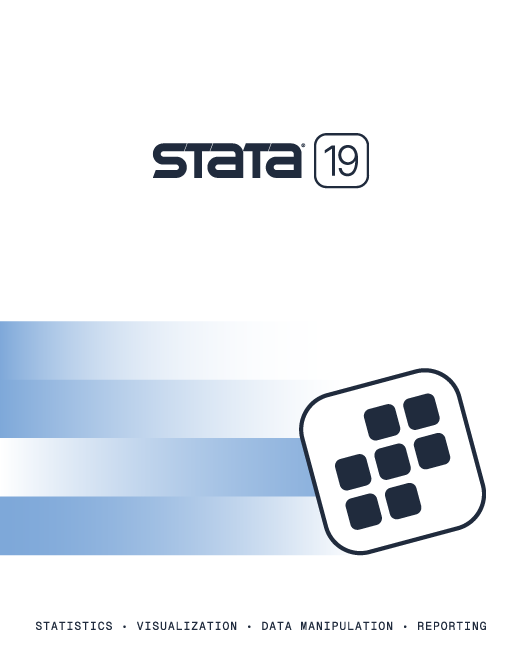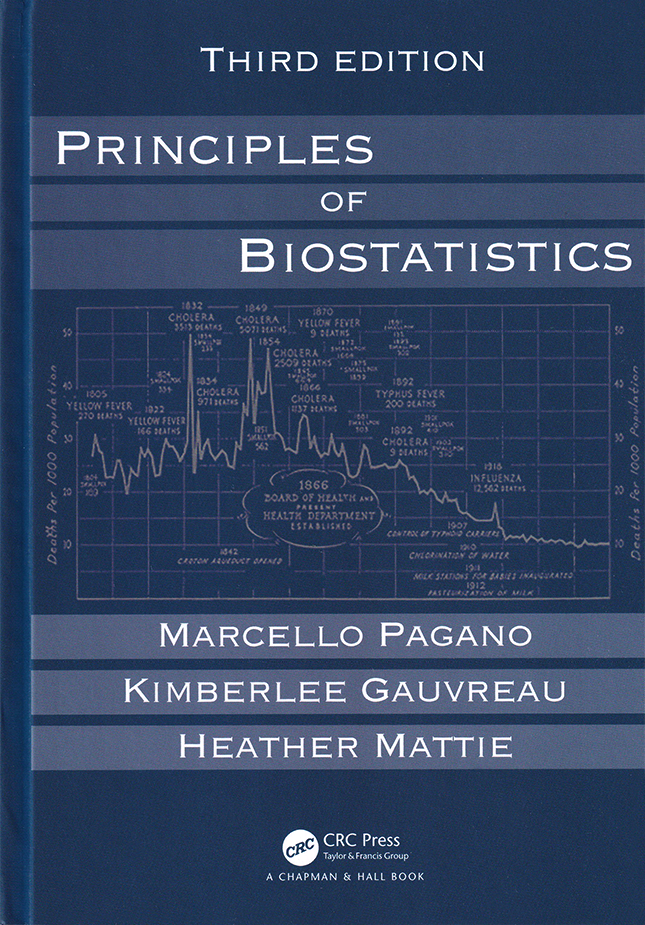

2025 Stata Conference • Nashville, TN • 31 July–01 August
Principles of Biostatistics, Third Edition |
||||||||||||||||||||||||||||||||
 Click to enlarge See the back cover |

As an Amazon Associate, StataCorp earns a small referral credit from
qualifying purchases made from affiliate links on our site.
eBook not available for this title
eBook not available for this title |
|
||||||||||||||||||||||||||||||
Comment from the Stata technical groupThe third edition of Principles of Biostatistics by Marcello Pagano, Kimberlee Gauvreau, and Heather Mattie continues to be a wonderful tool for biological and health science students and researchers. The book is divided into three parts: "Variability" (three chapters), "Probability" (four chapters), and "Inference" (fourteen chapters). No prior statistical knowledge is assumed, and basic college math is adequate to understand the occasional mathematical formulas in the text. Many new topics have been introduced in the third edition, while other topics have been considerably improved and expanded. For instance, material covering screening and diagnostic tests has been given its own chapter. New sections on the Kruskal-Wallis test, the Cox proportional hazards model, and sample-size calculations for a two-sample test on means and proportions have been added. Given the importance of different study designs, a new chapter (the final one) highlights the different characterstics of study designs for randomized and observational studies. A 14-page glossary of definitions for statistical terms has been added to the end of the book as well. Each chapter now has summary boxes that include the relevant mathematical formulas for ease of reference. The new edition also expands the Review Exercises sections and continues to use real published datasets that are available here. Stata and R code for the computer output in the book are also provided. |
||||||||||||||||||||||||||||||||
Table of contentsView table of contents >> 1. Introduction
1.1 Why Study Biostatistics
1.2 Difficult Numbers 1.3 Overview of the Text
1.3.1 Part I: Chapters 2–4 Variability
1.4 Review Exercises1.3.2 Part II: Chapters 5–8 Probability 1.3.3 Part III: Chapters 9–22 Inference 1.3.4 Computing Resources I Variability
2. Descriptive Statistics
2.1 Types of Numerical Data
2.1.1 Nominal Data
2.2 Tables
2.1.2 Ordinal Data 2.1.3 Ranked Data 2.1.4 Discrete Data 2.1.5 Continuous Data
2.2.1 Frequency Distributions
2.3 Graphs
2.2.2 Relative Frequency
2.3.1 Bar Charts
2.4 Numerical Summary Measures2.3.2 Histograms 2.3.3 Frequency Polygons 2.3.4 Box Plots 2.3.5 Two-Way Scatter Plots 2.3.6 Line Graphs
2.4.1 Mean
2.5 Empirical Rule2.4.2 Median 2.4.3 Mode 2.4.3 Range 2.4.5 Interquartile Range 2.4.6 Variance and Standard Deviation 2.6 Further Applications 2.7 Review Applications 3. Rates and Standardization
3.1 Rates
3.2 Adjusted Rates
3.2.1 Direct Standardization
3.3 Further Applications 3.2.2 Indirect Standardization 3.4 Review Exercises 4. Life Tables
4.1 Historical Development
4.2 Life Table as a Predictor of Longevity 4.3 Mean Survival 4.4 Median Survival 4.5 Further Applications 4.6 Review Exercises II Probability
5. Probability
5.1 Operations on Events and Probability
5.2 Conditional Probability 5.3 Total Probability Rule 5.4 Relative Risk and Odds Ratio 5.5 Further Applications 5.6 Review Exercises 6. Screening and Diagnostic Tests
6.1 Sensitivity and Specificity
6.2 Bayes' Theorem 6.3 Likelihood Ratios 6.4 ROC Curves 6.5 Calculation of Prevalence 6.6 Varying Sensitivty 6.7 Further Applications 6.8 Review Exercises 7. Theoretical Probability Distributions
7.1 Probability Distributions
7.2 Binomial Distribution 7.3 Poisson Distribution 7.4 Normal Distribution 7.5 Further Applications 7.6 Review Exercises 8. Sampling Distribution of the Mean
8.1 Sampling Distributions
8.2 Central Limit Theorem 8.3 Applications of the Central Limit Theorem 8.4 Further Applications 8.5 Review Exercises III Inference
9. Confidence Intervals
9.1 Two-Sided Confidence Intervals
9.2 One-Sided Confidence Intervals 9.3 Student’s t Distribution 9.4 Further Applications 9.5 Review Exercises 10. Hypothesis Testing
10.1 General Concepts
10.2 Two-Sided Tests of Hypothesis 10.3 One-Sided Tests of Hypothesis 10.4 Types of Error 10.5 Power 10.6 Sample Size Estimation 10.7 Further Applications 10.8 Review Exercises 11. Comparison of Two Means
11.1 Paired Samples
11.2 Independent Samples
11.2.1 Equal Variances
11.3 Sample Size Estimation for Two Means 11.2.2 Unequal Variances 11.4 Further Applications 11.5 Review Exercises 12. Analysis of Variance
12.1 One-Way Analysis of Variance
12.1.1 The Problem
12.2 Multiple Comparisons Procedures12.1.2 Sources of Variation 12.3 Further Applications 12.4 Review Exercises 13. Nonparametric Methods
13.1 Sign Test
13.2 Wilcoxon Signed-Rank Test 13.3 Wilcoxon Rank Sum Test 13.4 Kruskal-Wallis Test 13.5 Advantages and Disadvantages of Nonparametric Methods 13.6 Further Applications 13.7 Review Exercises 14. Inference on Proportions
14.1 Normal Approximation to the Binomial Distribution
14.2 Sampling Distribution of a Proportion 14.3 Confidence Intervals 14.4 Hypothesis Testing 14.5 Sample Size Estimation 14.6 Comparison of Two Proportions 14.7 Sample Size Estimation for Two Proportions 14.8 Further Applications 14.9 Review Exercises 15. Contingency Tables
15.1 The Chi-Square Test
15.1.1 2 x 2 Tables
15.2 McNemar’s Test 15.1.2 r x c Tables 15.3 The Odds Ratio 15.4 Berkson’s Fallacy 15.5 Further Applications 15.6 Review Exercises 16. Correlation
16.1 Two-Way Scatter Plot
16.2 Pearson Correlation Coefficient 16.3 Spearman Rank Correlation Coefficient 16.4 Further Applications 16.5 Review Exercises 17. Simple Linear Regression
17.1 Regression Concepts
17.2 The Model
17.2.1 Population Regression Line
17.3 Evaluation of the Model
17.2.2 Method of Least Squares 17.2.3 Inference for Regression Coefficients 17.2.4 Inference for Predicted Values
17.3.1 Coefficient of Determination
17.4 Further Applications17.3.2 Residual Plots 17.3.3 Transformations 17.5 Review Exercises 18. Multiple Linear Regression
18.1 The Model
18.1.1 Least Squares Regression Equation
18.2 Model Selection18.1.2 Inference for Regression Coefficients 18.1.3 Indicator Variables 18.1.4 Interaction Terms 18.3 Evaluation of the Model 18.4 Further Applications 18.5 Review Exercises 19. Logistic Regression
19.1 The Model
19.1.1 Logistic Function
19.2 Indicator Variables19.1.2 Fitted Equation 19.3 Multiple Logistic Regression 19.4 Simpson's Paradox 19.5 Interaction Terms 19.6 Model Selection 19.7 Further Applications 19.8 Review Exercises 20. Survival Analysis
20.1 Life Table Method
20.2 Product-Limit Method 20.3 Log-Rank Test 20.4 Cox Proportional Hazards Model 20.5 Further Applications 20.6 Review Exercises 21. Sampling Theory
21.1 Sampling Designs
21.1.1 Simple Random Sampling
21.2 Sources of Bias21.1.2 Systematic Sampling 21.1.3 Stratified Sampling 21.1.4 Cluster Sampling 21.1.5 Ratio Estimator 21.1.6 Two-Stage Cluster Sampling 21.1.7 Design Effect 21.1.8 Nonprobability Sampling 21.3 Further Applications 21.4 Review Exercises 22. Study Design
22.1 Randomized Studies
22.1.1 Control Groups
22.2 Observational Studies 22.1.2 Randomization 22.1.3 Blinding 22.1.4 Intention to Treat 22.1.5 Crossover Trial 22.1.6 Equipoise
22.2.1 Cross-Sectional Studies
22.3 Big Data22.2.2 Longitudinal Studies 22.2.3 Case-Control Studies 22.2.4 Cohort Studies 22.2.5 Consequences of Design Flaws 22.4 Review Exercises Bibliography
Glossary
Statistical Tables
Index
|
||||||||||||||||||||||||||||||||
Learn
Free webinars
NetCourses
Classroom and web training
Organizational training
Video tutorials
Third-party courses
Web resources
Teaching with Stata
© Copyright 1996–2025 StataCorp LLC. All rights reserved.
×
We use cookies to ensure that we give you the best experience on our website—to enhance site navigation, to analyze usage, and to assist in our marketing efforts. By continuing to use our site, you consent to the storing of cookies on your device and agree to delivery of content, including web fonts and JavaScript, from third party web services.
Cookie Settings
Last updated: 16 November 2022
StataCorp LLC (StataCorp) strives to provide our users with exceptional products and services. To do so, we must collect personal information from you. This information is necessary to conduct business with our existing and potential customers. We collect and use this information only where we may legally do so. This policy explains what personal information we collect, how we use it, and what rights you have to that information.
These cookies are essential for our website to function and do not store any personally identifiable information. These cookies cannot be disabled.
This website uses cookies to provide you with a better user experience. A cookie is a small piece of data our website stores on a site visitor's hard drive and accesses each time you visit so we can improve your access to our site, better understand how you use our site, and serve you content that may be of interest to you. For instance, we store a cookie when you log in to our shopping cart so that we can maintain your shopping cart should you not complete checkout. These cookies do not directly store your personal information, but they do support the ability to uniquely identify your internet browser and device.
Please note: Clearing your browser cookies at any time will undo preferences saved here. The option selected here will apply only to the device you are currently using.